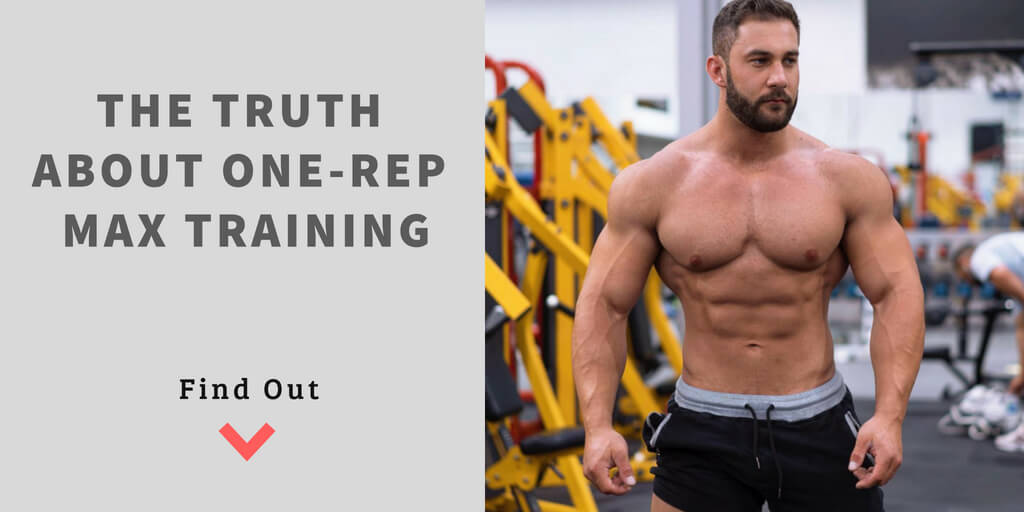Ever wonder what your 1RM (one-rep max) is?
Stop right there. And ask yourself this question: Do you really need to know?
If your primary goal is to shred fat, build muscle, or transform your body, single-rep sets aren’t really going to help you get there.
Before you start loading more plates on the bar, give this one-rep max fail some thought:
One-Rep Max Powerlifting Fail
At the Irish Powerlifting National Championships in 2015, competitor Tommy Dolan took all the necessary precautions to try and set a one-rep-max squat record.[1]
Proper training. Knee wraps and weight belt. Warm-up lifts. Spotters.
And then he loaded the bar with 617 pounds (280kg) (a one-rep max squat he completed in training at least once before). He gets into position. Adjusts his feet. And the spotters release the bar.
Dolan begins the squat, bending at the hips and knees. But halfway to the bottom of the squat, something happens.
There’s a quick “pop-pop” sound and Dolan collapses. And both quadricep muscles completely tear away from the bone in pursuit of the one-rep-max.
The injury required major surgery, time in a wheelchair, and months of physical therapy.
The Risks of One-Rep Max Lifting
If you’re competing in powerlifting competitions like Dolan, it makes sense to incorporate one-rep max lifts into your training plan.
But if you’re not competing, and you’re more interested in physique goals, the risks associated with the one-rep max might outweigh the benefits.
Yes. You can get stronger with one-rep max training, but it’s not as effective at building muscle as hypertrophy training, primarily because the volume isn’t there.
One-rep max training also has some unique risks such as:
- Increased risk for injury. You might not sustain an injury like Dolan by attempting a one-rep max on any lift, but it puts your muscles under significantly greater stress. And at greater risk for injuries such as muscle and ligament strains, tendon tears or ruptures, and chronic pain.[2]
- Significant stress on central nervous system. Research shows that the kind of all-out-maximum effort commonly associated with one-rep-max training can fatigue the central nervous system and impact the body’s ability to store energy needed for recovery and subsequent workouts. [3]
- Greater muscle soreness and recovery time. One-rep max training can cause significant muscle/tissue damage. That’s necessary to stimulate gains in muscle and strength, but in excess can increase muscle soreness and require longer recovery times.
- Less effective than hypertrophy training. If you’re chasing a powerlifting record as a PR or in competition, one-rep-max training makes sense. But if your goals are more aligned with aesthetics, shredding fat, building lean muscle, and transforming the way you look, hypertrophy training (3 to 5 sets, 8 to 12 reps per set, at 75% to 85% of one-rep max) is more effective. [4]
If You Must Know Your 1RM…
The rules are pretty simple.
- Take your time to build muscle, strength and endurance.
- Focus on volume with hypertrophy training first.
- Master your lifts using lighter weights, higher reps, good form, and a slow and controlled lifting tempo.
- Add in sets designed to build strength (3 to 5 reps) to your program.
- When you’re ready to attempt a 1RM lift, warm-up, stretch, complete some lighter-weight sets.
- Use a spotter.
- And don’t make 1RM training a regular thing, if you’re mainly after physique goals.
Calculate 1RM
There’s also another way to figure out your 1RM without ever handling super heavy weights, and putting yourself at higher risk for injury.
Calculate your 1RM based on the number of reps you can complete using a lighter load. Use this calculator to predict your 1RM.
My 440-Pound Bench Press PR
A couple years ago, I met up with my friend and Muscle Nation co-founder Chris Anastasi for a chest-day workout.
We’ve been training off and on together for years. On that day, we worked through a series of warm-up exercises and lighter lifts. And then I decided to take a shot at setting a PR on the bench press.
The result: A bench press 1RM of 440 pounds (200 kg).
But it’s not something I do every day. I haven’t chased a 1RM like that since. Not because I can’t. But because I’d rather lift consistently, stay lean and muscular, and avoid an injury that could keep me out of the gym for weeks or even longer.
That’s my take on the one-rep max. It might be a fun way to test your limits in the gym, but in the big picture of bodybuilding, transformations, and lean muscle to look your best, hypertrophy training is the way to go.
Looking for a training and nutrition plan to get lean, build muscle, and transform your body? Start here.
References
1. Irish Powerlifting Organisation. (2015). IPO National Powerlifting Championships April 4-5, 2015. From: powerliftingireland.com/irish-powerlifting-organisation-ipo-national-powerlifting-championships-4th-and-5th-april-2015/
2. Golshani, K., et al. (2018). Upper extremity weightlifting injuries: Diagnosis and management. Journal of Orthopaedics. From: https://www.sciencedirect.com/science/article/pii/S0972978X17301332
3. Zajac, A., et al. (2015). Central and peripheral fatigue during resistance exercise: A critical review. Journal of Human Kinetics. From: https://www.ncbi.nlm.nih.gov/pmc/articles/PMC4723165/
4. Esco, M. (2013). Resistance training for health and fitness. American College of Sports Medicine. From: https://www.acsm.org/docs/brochures/resistance-training.pdf

